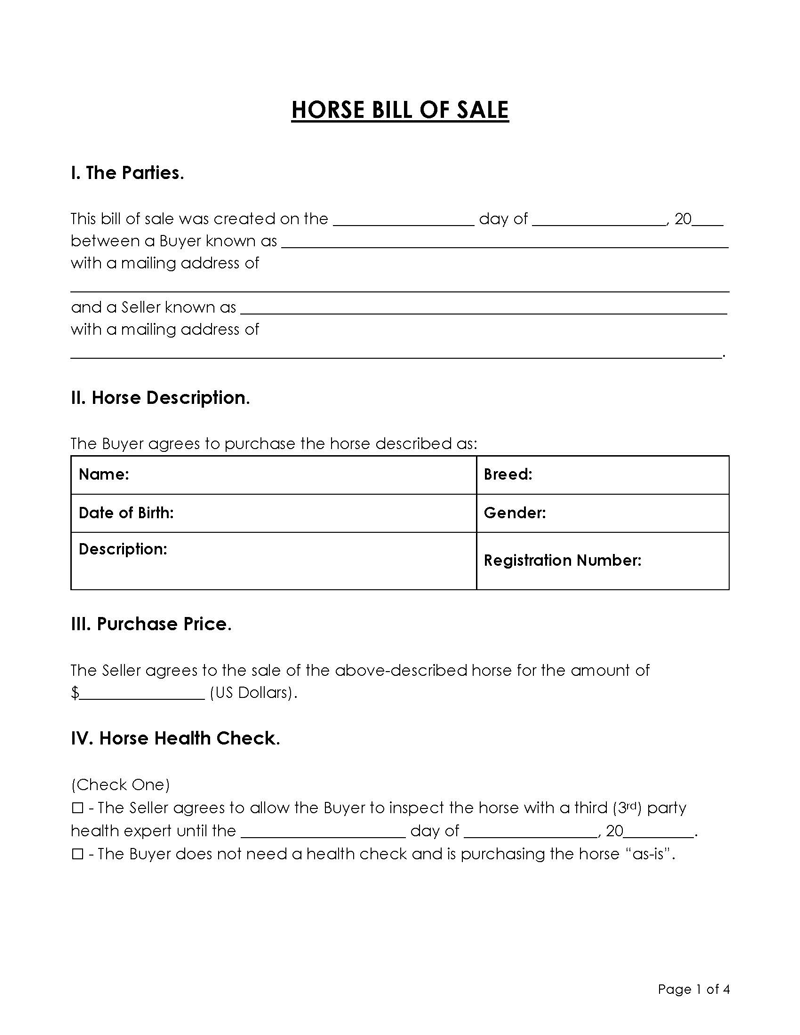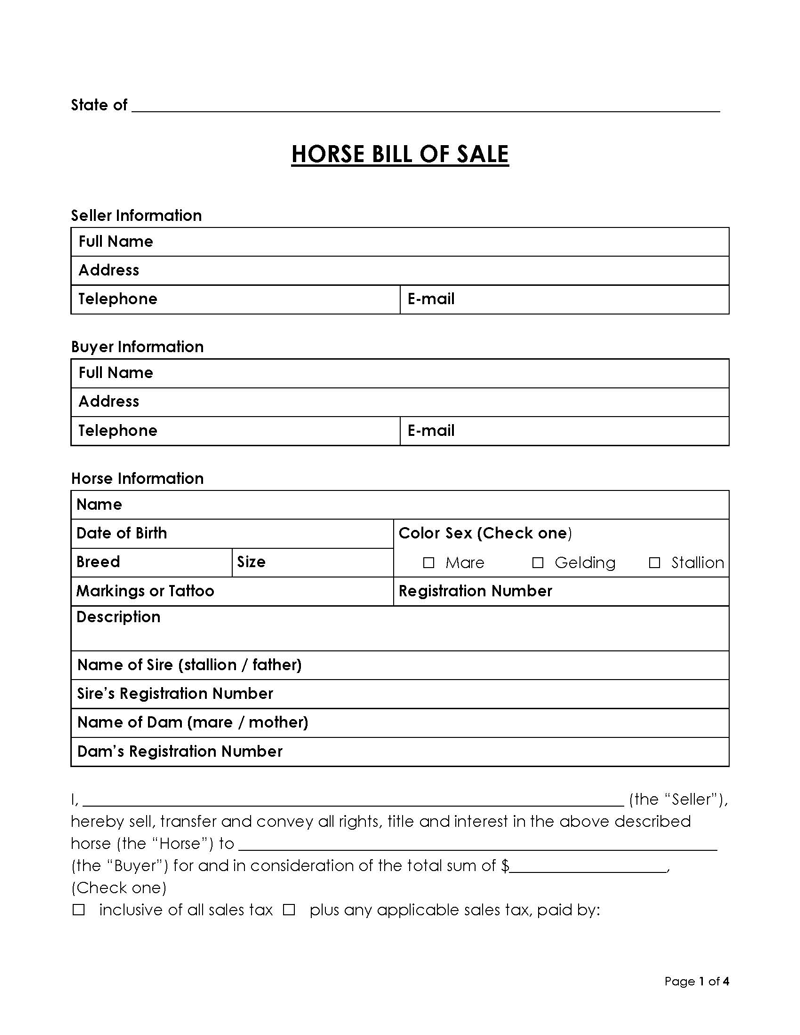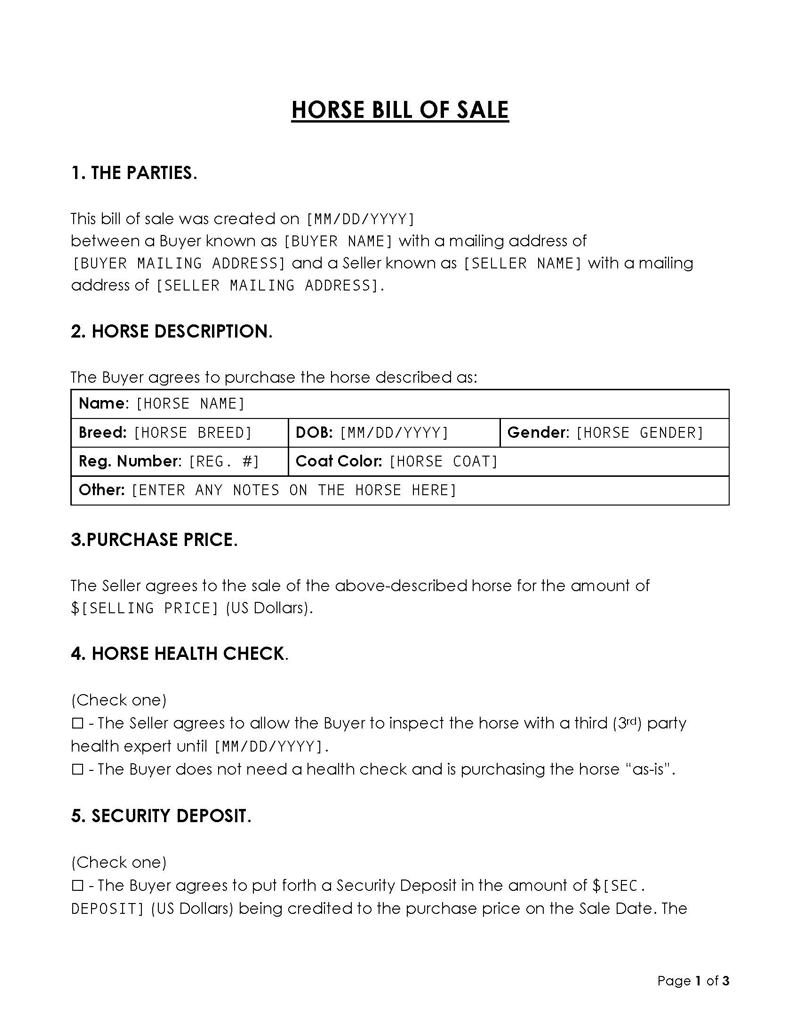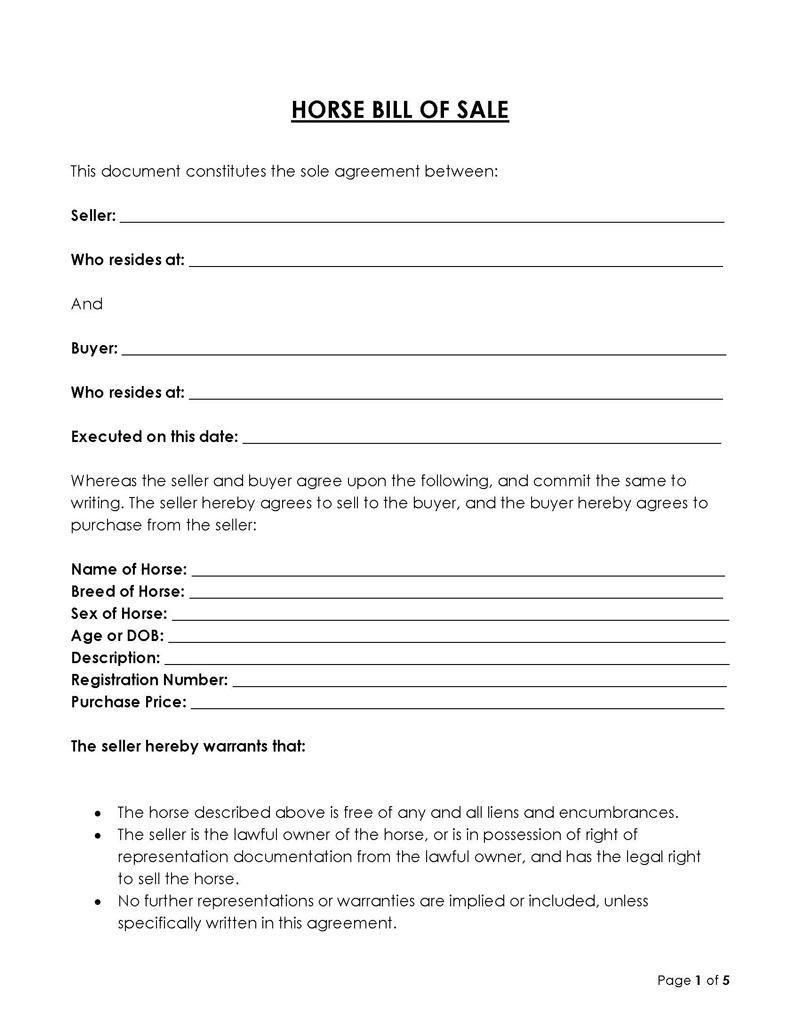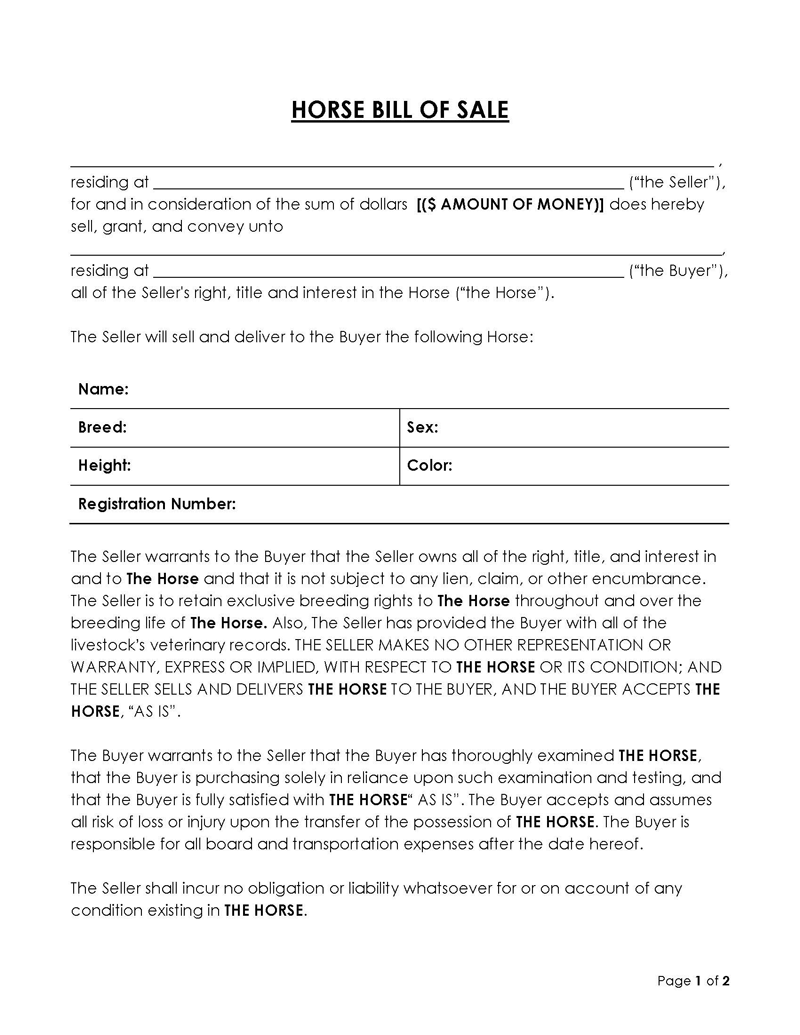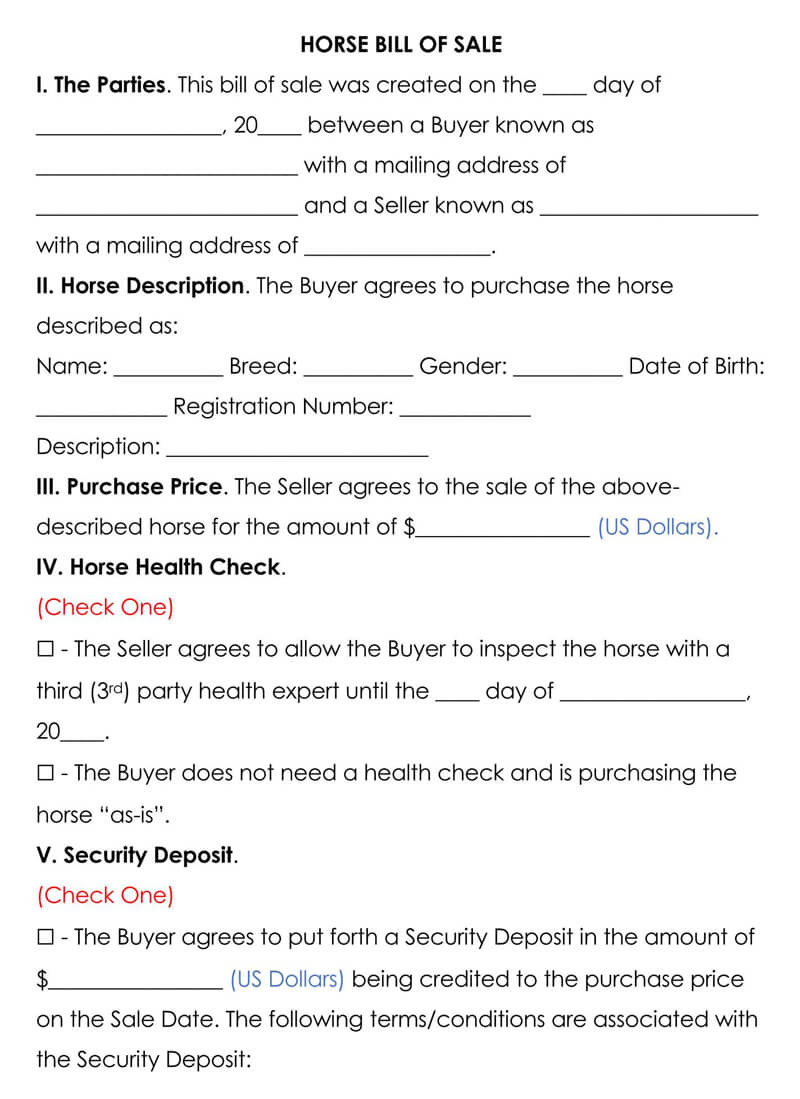The Horse Bill of Sale Form is a legally binding document used in the transfer of ownership of a horse by a seller to a buyer. It acts as a record of the legal transaction and ensures that the rights of all parties involved in the deal are secured.
A horse bill of sale form is a pre-build template to document the transaction information of the parties involved (seller and buyer) in transferring a horse’s ownership. It is used to ensure that information regarding the sale or change of horse ownership is logically recorded. It also helps ensure that all relevant aspects of the sale are outlined; therefore, no transaction details are missed by the seller or the buyer. We have free downloadable horse bill of sale form templates to help you ensure a successful transaction. Feel free to download our templates from our website to help ensure that your horse sale is well documented.
A horse bill of sale form may be referred to as the
- Equine bill of sale
- Equine contract of sale
- Equine bill of the sale agreement
- Horse purchase agreement
- Equine purchase agreement
- Bill of sale for a horse
- Horse bill of sale agreement
When is the Horse Bill of Sales Required?
A horse bill of sale form should be used by a seller that puts a horse on the market. It should also be used when a horse owner decides to transfer ownership of a horse. A horse bill of sale ensures that there is proof of a change of ownership.
Sellers may also use the horse bill sale form in the following situations:
- The seller provides a receipt to the buyer to show the proof of ownership.
- The seller wants to record the transaction details and includes information such as the price of the horse and the buyer’s details.
- The seller wants to outline in writing the terms and conditions of the sale, such as information stating that the seller cannot reclaim the horse once sold to the buyer or that the buyer accepts the horse “as is and therefore cannot demand a refund after the sale.
- The seller wants to record the number of horses sold to a buyer and their lineage.
- The private seller wants to ensure that the transfer of ownership of the horse is legitimately recorded in writing.
- The seller wants protection against liabilities associated with the horse after the sale or if the seller wants to prove that the buyer has assumed responsibility for issues associated with the horse.
The horse bill of sale form may also be used as a legal instrument that provides how, where, and when the sale occurred. It ensures that both parties can refer to the document when or if a dispute over the sale or the horse itself arises.
Note: Some states have made the bill of sale form a compulsory document used in the transaction or change of horse ownership. These states include Florida, California, and Kentucky.
Free Templates
Essential Components
A horse bill of sale form needs to explain who the parties involved in the transaction are, what price the parties had agreed on, where the horse is registered and what its registration number is, when the sale took place and how the warranty and condition of the horse have been negotiated. Including these elements in the horse bill of sale form ensures that adequate details regarding the sale are recorded.
The following are necessary details that must be included in the horse bill of sale form:
Date of sale
The horse bill of sale form should contain information on when the transfer or change of ownership took place. The date of the sale will ensure that the seller captured when responsibility relating to the horse was relinquished to the buyer.
Details of the seller
The seller’s name, address, and contact information should be indicated in the horse bill of sale form. The seller’s details will ensure that the individual that has put the horse on the market can be identified and contacted. It also helps ensure that the ownership of the horse can be traced back to the seller.
Details of the buyer
The buyer’s name, address, and contact information should also be included in the horse bill of sale form. Including the buyer’s details helps ensure that the seller can prove the identity of the new owner if ever required in the future.
Description of horse
The horse bill of sale form must include information on the breed of the horse, its gender, date of birth, and registration number. A proper description of the horse must also be provided to ensure that the horse sold can be identified. The description can include age, markings, tattoos, or the coat color of the horse. The seller may also include the horse’s name for further clarity on what animal has been sold.
Sire
Information detailing the horse’s father should also be included in the horse bill of sale form. The information provided must include the registration number of the horse’s father to ensure that the buyer is fully informed of the horse’s pedigree. The information on the sire can be helpful for a buyer intending on breeding,
Dam
The registration number of the horse’s mother should also be provided in the horse bill of sale form. It will ensure that the seller has provided the buyer with all the relevant information regarding the horse.
Purchase price information
The horse bill of sale form should indicate the price the horse has been sold and the mode of payment which may include the method of disbursement agreed, which may be a one-time payment or installments. In addition, the date of payment or when payment will be completed should also be provided. The purchase price information will ensure that the seller can prove all the relevant details regarding the monetary transaction with the buyer.
Warranties
The horse bill of sale form should contain information warranties if the horse is to be sold ‘as is or with guarantees. The warranty information will help the seller indicate the horse’s condition that the buyer accepted or agreed with.
Security deposit
If the seller and buyer have agreed to place a security deposit, then the horse bill of sale form should contain the amount agreed on and the terms of the deposit. The indication of the security deposit will help the seller provide adequate information on the amount paid as a deposit by a buyer and the terms and conditions associated with it.
A security deposit may be paid by a buyer who wishes to carry out a medical examination before the transaction entirely takes place. The deposit is usually deducted from the agreed cost if both parties decide to continue with the change of ownership.
Signatures of the seller, buyer, and any witnesses/agent
The buyer and seller’s names and signatures must be indicated in the horse bill of sale as proof that they both agree with the details of the sale. Any witness/agent present for the signing should also indicate their name and signature. The date of signing must also be indicated to provide clarity on when the involved parties signed the horse bill of sale form.
Notary acknowledgment
The horse bill of sale form should also contain an acknowledgment by the notary that the document is authentic and the information can be trusted. The acknowledgment should be dated and signed by the buyer, seller, and notary public. It helps show that the buyer and seller willingly signed the horse bill of sale form. The acknowledgment should also contain the state’s name to verify which state authenticated the bill of sale.
Additional Considerations
A seller may also consider including additional information in the horse bill of sale form to ensure that its terms and conditions are well detailed. It will help mitigate any disputes that may arise about the sale.
The seller can opt to add the following in the horse bill of sale form:
Breeding rights
The breeding rights aren’t always automatically transferred when a horse is sold. Instead, the seller may indicate whether or not there are any limits or permission must be granted for the buyer to breed. The information on the breeding rights will inform the buyer of any breeding restrictions surrounding the animal.
Commission
If the buyer or seller has commissioned the help of a third-party/broker, such as an agent or trainer, to help negotiate the sale, then the horse bill of sale should contain information on how much will be paid to the broker. Usually, the fixed amount or percentage of the total payment is paid to third-party brokers.
Deposit
Sometimes the seller may request the buyer to deposit a show of good faith while assessing the horse. In such a case, the horse bill of sale form should contain information on the conditions under which a refund of the deposit should be made by the seller, such as if the animal is found to have poor health by a veterinarian.
Registration papers
The seller can indicate when the horse’s legal registration papers will be transferred to the buyer, ensuring that it belongs to the exact horse sold. In addition, the registration papers will ensure that the buyer has the appropriate paperwork to prove ownership of the horse.
Veterinarian’s examination
If the horse is being sold ‘as is,’ the seller can indicate in the horse bill of sale form whether the buyer is allowed to enlist the help of a veterinarian to conduct a medical examination of it, such as a blood analysis before the sale. A veterinarian’s examination will ensure the buyer is satisfied with the medical status of the horse during the sale.
How to Sell a Horse?
Before a seller can write a horse bill of sale form, it is essential that they first comprehend the step-by-step process of selling a horse. It will help the seller ensure that everything connected to the sale or transfer of ownership is included in the horse bill of sale.
The following step by step process can be used to ensure the process of selling a horse goes by smoothly:
Step 1: Estimate the value
First, the seller should estimate a reasonable value for the horse. The estimated value for the horse is based on several factors. These factors will ensure that the seller does not overprice the horse. The seller must remember that the estimated price is a starting point and may change after negotiations with a buyer.
The factors impacting the value of the horse include:
- Height and weight : The seller must consider the height and weight of the horse when estimating the price. If the horse has a healthy weight and meets its breed’s average height, then it may fetch a reasonable price. However, sellers must be aware that ponies and regular-sized horses sell at different prices; therefore, this must be factored in.
- Age of the animal : The seller should research and determine at what price horses of a certain age can be valued. It will provide the seller with an appropriate price to value the horse. In addition, the seller can check the price of horses within the age group of the one placed on the market.
- Gender of the animal: The gender of the horse may also impact its price. It is especially true if the buyer’s intention is breeding. Often male horses sell for a higher price than female horses.
- Color of the coat : The seller should also consider the color of the horse’s coat. Again, it is an essential factor, especially if the seller plans to sell the animal as a luxury horse. In such a case, the color of the coat can impact the estimated value as appearance is crucial.
- The bloodline : Horses with what buyers consider to be a good bloodline are known to sell for considerable prices. It is particularly true for racing horses. Therefore, the seller must find out the horse’s bloodline and its value in the market.
- Temperament : Temperament is the overall behavior of a horse. It can be determined by the horse’s age, breed, and environment. Temperament should be considered as it will determine how cooperative the animal is. Uncooperative horses may deter buyers; therefore, the seller must factor it in when formulating an estimate.
- Trained/Not trained : The seller should also consider the type of training the horse has received. Horses that are professionally trained for activities such as sports often fetch a high price. The seller may also consult a horse trainer to help determine a price for the horse’s type of training.
- Specific skills : The seller should consider the horse’s specific skill set that it has been bred for. For example, some horses are skilled in performing well-trained stunts. Such information may be of value to the buyer; therefore, it can ensure the seller gets the best value.
- Good health : The seller should consider obtaining the help of a veterinarian to determine the state of the horse’s health. Healthy horses are sold at a higher price; therefore, factoring in the horse’s health status will ensure that the seller formulates a good price.
Step 2: Create a post (advertisement)
Advertising ensures buyers are aware that a seller’s horse is up for sale. The seller can post advertisements of the horse in the local newspapers or magazines. Horse shows also provide the seller with an opportunity to advertise the animal. Getting the word out to as many horse show attendees can lead to several offers by buyers.
Few general websites can also be used to advertise horses.
These include:
- craigslist.org– The seller can post information on the horse in the ‘for sale’ area’ under the ‘Farm+ garden’ section
- Facebook.com– The seller can also advertise the sale on Facebook and share information about the animal with other horse lovers on the platform
The seller can also advertise the horse online using various reliable websites such as:
- HorseClick.com
- DreamHorse.com
- Equine.com
When creating the advertisement, the seller should ensure the following:
Pictures and videos
The seller should take clear photos or videos of the horse to be placed in the advertisement. No image editing tools that can alter the appearance of the horse should be used. The horse should be captured fully with its marks, scars, or brand. The seller should try and capture the horse while it is active to show the potential buyers that it is a healthy and happy animal.
General information
A seller must then ensure that the advertisement contains general information about the horse. The provision of the general information will ensure that the buyer is familiar with basic details about the animal.
The seller should state the following general information:
- Posting title: The seller should write a catchy posting title to capture a potential buyer’s attention. However, the seller should ensure that it is not too over the top or exaggerated.
- Price: The estimated value formulated by the seller should be indicated in the post. It will inform potential buyers capable of meeting the price range that the horse is up for sale.
- Location: The location of the animal should also be provided in the posting. The location will inform the buyer where to find the horse.
- Contact information: The seller’s name, phone number, and email address should be provided in the contact information. The contact details provided will enable interested buyers to contact the seller quickly.
Description
A detailed description of the horse should also be provided. It should include key information that a potential buyer may be interested in knowing. The description details should comprise the horse’s age, weight, height, gender, breed, training, behavior, and medical history.
Step 3: Meet with the potential buyer
The seller should set up a schedule to meet potential buyers interested in the horse. The horse should be well groomed to make it presentable when shown to the buyer. A seller may enlist the help of a veterinarian who will conduct a physical medical examination before presenting the animal to the buyer. The physical examination will ensure that the horse is healthy enough to be sold at an excellent price to an interested buyer. In addition, the seller should provide potential buyers with a detailed medical history of the horse, mainly if the animal will be sold ‘as is.’
Step 4: Negotiate
When the seller finds a buyer interested in making the purchase, negotiations on the horse should start. The seller should ensure that information on the terms and conditions of the sale are discussed, along with the price the buyer is willing to pay. The seller should also record any points agreed on with the buyer to be included in the horse bill of sale form.
Step 5: Close the deal
Once the negations have been concluded, the seller should organize and deliver relevant documents concerning the horse to the buyer. The documents may include the horse’s registration documents, vet records, DNA results, among others. In addition, the buyer and the seller should both have a copy of the horse bill of sale form. Each copy should be completed and signed by the two parties. The seller should then ensure that the buyer has already made the payment before the horse is transferred. Once the horse leaves with its new owner, then the seller can consider the deal finalized.
Free Form
Get free downloadable horse bill of sale form template:
Final Words
A horse bill of sale form records the transaction between the seller of a horse and the buyer. It ensures that all the information relating to the transaction is recorded and acts as proof that the horse’s ownership has been transferred to the buyer. The seller of a horse should ensure that the horse bill of sale contains detailed information about the horse, its price, and any terms agreed on with the buyer.
